
Krome Studios Melbourne, originally Beam Software, was an Australian video game development studio founded in 1980 by Alfred Milgrom and Naomi Besen and based in Melbourne, Australia. Initially formed to produce books and software to be published by Melbourne House, a company they had established in London in 1977, the studio operated independently from 1987 until 1999, when it was acquired by Infogrames, who changed the name to Infogrames Melbourne House Pty Ltd.. In 2006 the studio was sold to Krome Studios.
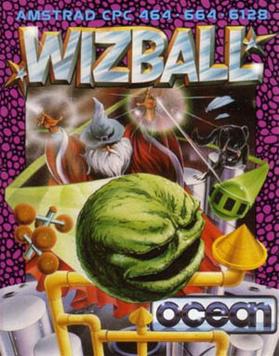
Wizball is a horizontally scrolling shooter written by Jon Hare and Chris Yates and released in 1987 for the Commodore 64 and later in the year for the ZX Spectrum and Amstrad CPC. Versions for the Amiga and Atari ST were released in the following year. Wizball was also ported to IBM PC compatibles and the Thomson MO5.

Ghostbusters is a licensed game by Activision based on the film of the same name. It was designed by David Crane and released for several home computer platforms in 1984, and later for video game console systems, including the Atari 2600, Master System and Nintendo Entertainment System. The primary target was the Commodore 64 and the programmer for the initial version of the game was Adam Bellin. All versions of the game were released in the USA except for the Amstrad CPC and ZX Spectrum versions, which were released only in Europe, and the MSX version, which was released only in Europe, South America, and Japan.

Emlyn Hughes International Soccer (EHIS) is a soccer computer game first released in 1988 by Audiogenic Software Ltd. The game is named after the popular English footballer Emlyn Hughes. It initially appeared on the Commodore 64, with other versions produced for the Amstrad CPC, ZX Spectrum, Atari ST and Amiga.

Blitz is an action game published by Commodore for its VIC-20 home computer in 1981. The game is based on the 1977 arcade video game Canyon Bomber from Atari, Inc., with the goal of clearing boulders replaced with bombing closely packed skyscrapers. Several later clones of the concept also use the urban setting. The game is played with a single button which drops a bomb.
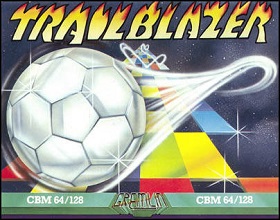
Trailblazer is a racing video game developed by Mr. Chip Software and published by Gremlin Graphics for the ZX Spectrum, Commodore 64, Atari 8-bit computers, Amstrad CPC, Commodore 16 and Plus/4 in 1986. It was ported to the Amiga and Atari ST.
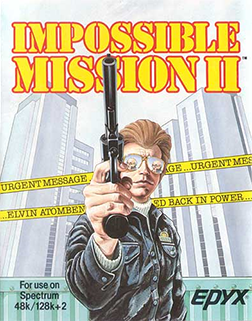
Impossible Mission II is a video game developed by Novotrade and published by Epyx in 1988. It was released for the Commodore 64, ZX Spectrum, Amstrad CPC, Enterprise 128, Nintendo Entertainment System, DOS, Atari ST, Apple II with at least 128K, Apple IIGS, and Amiga.
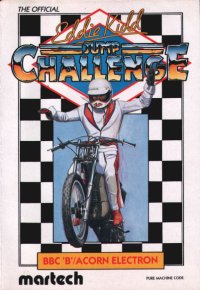
Eddie Kidd Jump Challenge is a stunt bike video game released for the Acorn Electron, BBC Micro, Commodore 64, MSX and ZX Spectrum first released in 1984, licensed by British stunt performer, Eddie Kidd.

Cybernoid: The Fighting Machine is a shoot 'em up developed and published in 1988 by Hewson Consultants for the ZX Spectrum. It was ported to the Amstrad CPC, Atari ST, Commodore 64, Amiga, and Nintendo Entertainment System. It was programmed by Raffaele Cecco. The ZX Spectrum, Amstrad, and Atari ST versions have a main theme by Dave Rogers, while the Commodore C64 version has a different theme by Jeroen Tel.

Knightmare is a video game released by Activision in 1987 for ZX Spectrum, Amstrad CPC, Commodore 64, and Atari ST. It was written by Mev Dinc, J.P. Dean, E.M. Dean and Nick Cooke, and is based on the Anglia Television show Knightmare. Four years later, Mindscape released entirely different game based on the show, also called Knightmare, for the Atari ST and Amiga.
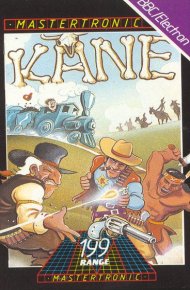
Kane is a multi-section action game published by Mastertronic for the Commodore 64 in 1986. It was ported to the Acorn Electron, Amstrad CPC, BBC Micro, ZX Spectrum, and the Commodore 16 and Plus/4. The game is set in the Wild West, and its name is a reference to the main character of the film High Noon. It consists of four distinct scenes, although some versions only contain two. A sequel was released in 1988.
Alligata Software Ltd. was a computer games developer and publisher based in Sheffield in the UK in the 1980s.

Zub is a 1986 platform video game designed by Ste and John Pickford, developed by Binary Design, and published by Mastertronic for the Amstrad CPC, Commodore 64 and ZX Spectrum. The game has the player control Zub, who has to travel to different planets to retrieve the Green Eyeball of Zub. A parody of the game Light Force, called Lightfarce, was added in as an easter egg. The music on all computers was composed by David Whittaker.

The Real Ghostbusters is a 1987 shoot 'em up arcade game developed and published by Data East. It is loosely based on Ghostbusters. In Japan, Data East released it as a non-Ghostbusters arcade game under the title Meikyuu Hunter G. In 1989, Activision published The Real Ghostbusters for Amiga, Amstrad CPC, Atari ST, Commodore 64, and ZX Spectrum.

Ace is a combat flight simulator video game published for the Commodore 64, VIC-20, and Plus/4 in 1985 by Cascade Games. It was ported to the Amstrad CPC, Amstrad PCW, Amiga, and ZX Spectrum.

Ghostbusters II is a 1989 action game based on the film of the same name. It was published by Activision for various computer platforms. British studio Foursfield developed a version for Commodore 64, Amiga, Atari ST, Amstrad CPC and ZX Spectrum, which also got ported to the MSX by New Frontier. It features three levels based on scenes from the film. Dynamix developed a separate version for the DOS, also based on the film. The non-DOS versions were praised for the graphics and audio, but criticized for long loading times, disk swapping, and the final level. The DOS, Commodore 64 and Amiga versions were the only versions released in North America.

Terminator 2: Judgment Day is a 1991 action video game developed by Dementia and published by Ocean Software. It is based on the 1991 film of the same name, and was released in Europe for Amiga, Amstrad CPC, Atari ST, Commodore 64, DOS, and ZX Spectrum. It is a sequel to The Terminator, itself based on the 1984 film of the same name. The game features several gameplay styles such as driving, fighting, and puzzle-solving.

Judge Dredd is a 1991 platform shoot 'em up video game based on the character of the same name. It was developed by Random Access and published by Virgin Mastertronic. It was released in Europe in 1991, for the Amiga, Atari ST, Commodore 64, and ZX Spectrum. Critics found the gameplay repetitive.
Toy Bizarre is a platform game written by Mark Turmell for the Commodore 64 and published by Activision in 1984. A port to the ZX Spectrum was released in 1985.



















